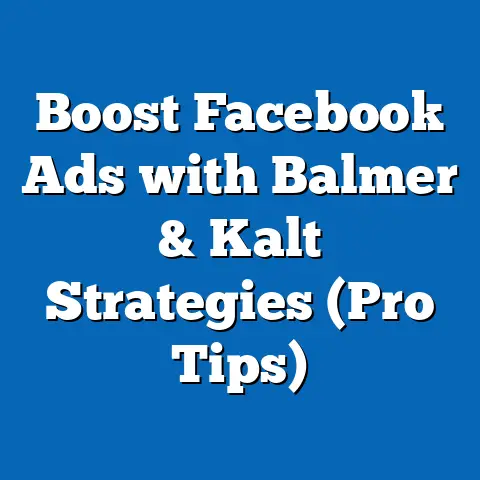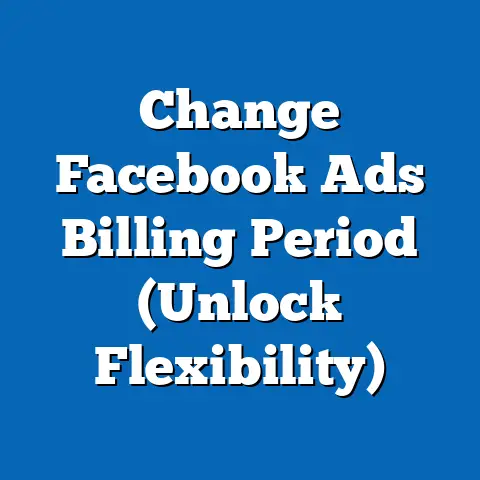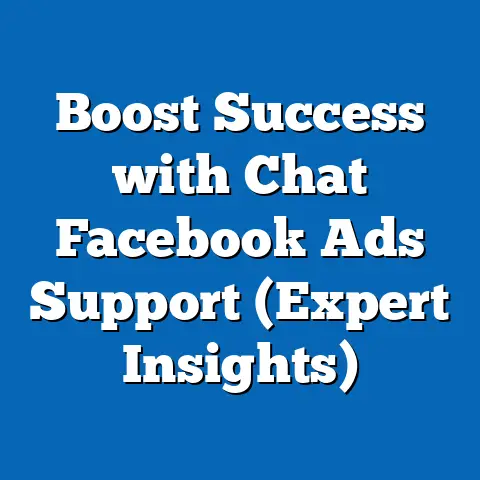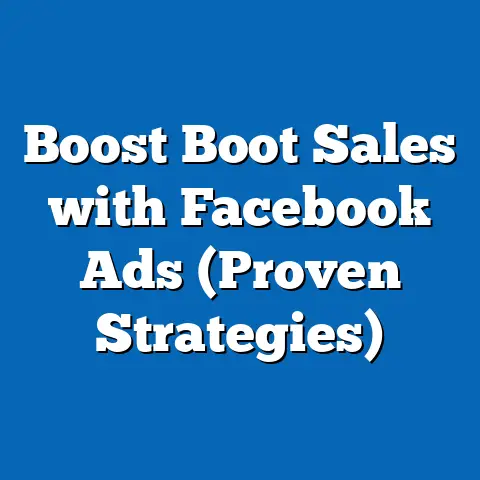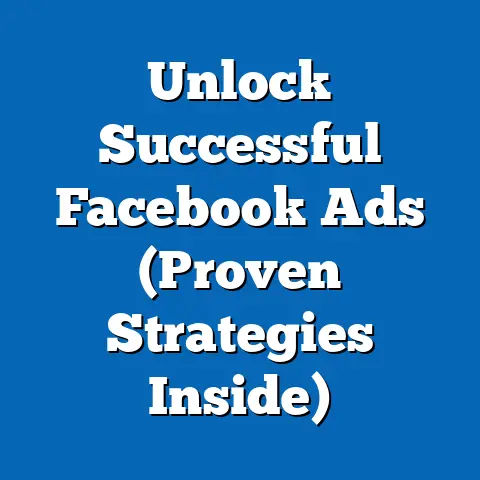Craft Irresistible CTAs for Facebook Ads (Proven Strategies)
Are your Facebook ads falling flat because your Call-to-Action (CTA) isn’t compelling enough? I get it. You pour time and effort into crafting the perfect ad, targeting the right audience, and creating eye-catching visuals, but the results are underwhelming. The missing piece? Often, it’s a lackluster CTA.
I’ve seen firsthand how a simple tweak to a CTA can dramatically improve conversion rates. In fact, in one campaign I ran for a local bakery, simply changing the CTA from “Learn More” to “Order Now & Get 10% Off” resulted in a 35% increase in online orders. It was a lightbulb moment that underscored the power of a well-crafted CTA.
Understanding the Importance of CTAs in Facebook Ads
Let’s start with the basics.
What is a Call-to-Action (CTA)?
A Call-to-Action, or CTA, is a marketing term that refers to a prompt designed to encourage an immediate response or desired action from the audience. It’s the instruction you give to your audience, telling them what you want them to do next. Think of it as the final push that guides potential customers toward conversion.
In the digital marketing world, CTAs typically take the form of a button, link, or text within an ad, email, website, or other marketing material. They are strategically placed to be highly visible and compelling, encouraging users to click, sign up, purchase, or take whatever action the marketer desires.
The Significance of CTAs in Facebook Ads
Facebook ads are designed to capture attention in a fast-paced, visually driven environment. But capturing attention is only half the battle. Once you have someone’s attention, you need to direct it towards a specific goal. That’s where the CTA comes in.
- Driving Conversions: A well-crafted CTA is the bridge between awareness and action. It tells users exactly what you want them to do, whether it’s visiting your website, signing up for a newsletter, or making a purchase. Without a clear CTA, users are left wondering what to do next, and you risk losing them.
- Improving ROI: CTAs directly impact the return on investment (ROI) of your Facebook ads. By guiding users towards conversion, CTAs help you maximize the value of your ad spend. A compelling CTA can significantly increase click-through rates (CTR) and conversion rates, ultimately leading to more sales and revenue.
- Guiding User Behavior: Facebook ads are often part of a larger marketing funnel. CTAs help guide users through this funnel, moving them from one stage to the next. For example, a CTA in an awareness ad might direct users to your website to learn more, while a CTA in a retargeting ad might encourage them to complete a purchase.
- Measuring Performance: CTAs provide valuable data that can be used to measure the performance of your Facebook ads. By tracking the click-through rates and conversion rates of different CTAs, you can identify what resonates with your audience and optimize your campaigns accordingly.
Statistics on the Impact of Effective CTAs
Numbers don’t lie. Here’s what some studies and statistics show about the power of effective CTAs:
- HubSpot: Found that personalized CTAs perform 202% better than basic, generic CTAs. This highlights the importance of tailoring your CTAs to specific audience segments and their needs.
- MarketingSherpa: Reported that using action-oriented language in CTAs can increase conversion rates by up to 93%. This underscores the importance of using strong verbs and phrases that motivate users to take action.
- WordStream: Showed that adding a sense of urgency to CTAs can increase conversions by as much as 332%. This demonstrates the power of scarcity and limited-time offers in driving immediate action.
Key Takeaway: A strong CTA is not an afterthought; it’s a crucial element of any successful Facebook ad campaign. It’s the engine that drives conversions, improves ROI, guides user behavior, and provides valuable data for optimization.
Analyzing Successful CTAs: What Makes Them Work?
Now that we understand the importance of CTAs, let’s dissect some successful examples and uncover the secrets behind their effectiveness. I’ve analyzed countless Facebook ad campaigns, and these are some of the patterns I’ve observed.
Deconstructing High-Performing CTAs
Let’s examine a few hypothetical examples and break down what makes them work:
-
Example 1: E-commerce Product Ad
- Visual: A high-quality image of a trendy new pair of sneakers.
- Headline: Step Up Your Style with These New Sneakers!
- Description: Limited-time offer! Get 20% off your first pair of these stylish sneakers.
- CTA: “Shop Now & Save”
- Analysis: This CTA is effective because it’s action-oriented, emphasizes the benefit (saving money), and creates a sense of urgency (limited-time offer). The word “Save” is particularly powerful because it directly appeals to the customer’s desire for a good deal.
-
Example 2: Lead Generation Ad for a SaaS Company
- Visual: A clean, professional graphic showcasing the SaaS platform’s dashboard.
- Headline: Streamline Your Workflow with Our Powerful SaaS Solution!
- Description: Ready to boost your productivity and save time? Sign up for a free trial today!
- CTA: “Start Free Trial”
- Analysis: This CTA is effective because it’s clear, concise, and directly addresses the user’s pain points (boosting productivity and saving time). The phrase “Free Trial” is a strong incentive that encourages users to take the next step without any financial risk.
-
Example 3: Event Promotion Ad
- Visual: An engaging video showcasing highlights from previous events.
- Headline: Join Us for the Biggest Marketing Conference of the Year!
- Description: Network with industry leaders, learn the latest trends, and grow your business.
- CTA: “Get Your Ticket Now”
- Analysis: This CTA is effective because it creates a sense of exclusivity and importance. The phrase “Get Your Ticket Now” implies that tickets are limited and encourages users to act quickly to avoid missing out.
Example 1: E-commerce Product Ad
- Visual: A high-quality image of a trendy new pair of sneakers.
- Headline: Step Up Your Style with These New Sneakers!
- Description: Limited-time offer! Get 20% off your first pair of these stylish sneakers.
- CTA: “Shop Now & Save”
- Analysis: This CTA is effective because it’s action-oriented, emphasizes the benefit (saving money), and creates a sense of urgency (limited-time offer). The word “Save” is particularly powerful because it directly appeals to the customer’s desire for a good deal.
Example 2: Lead Generation Ad for a SaaS Company
- Visual: A clean, professional graphic showcasing the SaaS platform’s dashboard.
- Headline: Streamline Your Workflow with Our Powerful SaaS Solution!
- Description: Ready to boost your productivity and save time? Sign up for a free trial today!
- CTA: “Start Free Trial”
- Analysis: This CTA is effective because it’s clear, concise, and directly addresses the user’s pain points (boosting productivity and saving time). The phrase “Free Trial” is a strong incentive that encourages users to take the next step without any financial risk.
Example 3: Event Promotion Ad
- Visual: An engaging video showcasing highlights from previous events.
- Headline: Join Us for the Biggest Marketing Conference of the Year!
- Description: Network with industry leaders, learn the latest trends, and grow your business.
- CTA: “Get Your Ticket Now”
- Analysis: This CTA is effective because it creates a sense of exclusivity and importance. The phrase “Get Your Ticket Now” implies that tickets are limited and encourages users to act quickly to avoid missing out.
Psychological Triggers in Effective CTAs
Successful CTAs don’t just tell people what to do; they tap into their underlying motivations and desires. Here are some of the key psychological triggers that effective CTAs leverage:
- Urgency: People are more likely to take action when they feel a sense of urgency. This can be created by using phrases like “Limited Time Offer,” “Sale Ends Soon,” or “While Supplies Last.”
- Scarcity: Similar to urgency, scarcity plays on the fear of missing out (FOMO). By highlighting that something is in limited supply, you can encourage users to act quickly before it’s gone.
- Exclusivity: People are drawn to things that are exclusive or only available to a select group. Using phrases like “Join Our Exclusive Community” or “Get Early Access” can make your offer more appealing.
- Curiosity: Arousing curiosity can pique interest and encourage users to click through to learn more. This can be achieved by using intriguing headlines or descriptions that leave the user wanting to know more.
- Social Proof: People are more likely to take action when they see that others have already done so. This can be achieved by including testimonials, reviews, or social media mentions in your ads.
- Benefit-Driven Language: Highlighting the benefits of taking action is crucial. Focus on what the user will gain by clicking your CTA, whether it’s saving money, improving their health, or achieving their goals.
Common Characteristics of High-Converting CTAs
Based on my experience, high-converting CTAs share several key characteristics:
- Clarity: The CTA should be clear and easy to understand. Users should know exactly what will happen when they click it.
- Brevity: Keep your CTAs short and to the point. Aim for a concise phrase that captures the essence of your offer.
- Action-Oriented Language: Use strong verbs and phrases that motivate users to take action.
- Visual Appeal: The CTA button should be visually appealing and stand out from the rest of the ad.
- Strategic Placement: Place your CTA in a prominent location where it’s easily visible to users.
- Relevance: The CTA should be relevant to the ad’s content and the target audience’s needs.
Key Takeaway: Understanding the psychological triggers and common characteristics of high-converting CTAs is essential for crafting effective Facebook ads. By analyzing successful examples and applying these principles, you can create CTAs that resonate with your audience and drive results.
Crafting Your Own CTAs: Proven Strategies
Now, let’s get practical. This section provides a step-by-step guide on how to create CTAs that resonate with your target audience and drive conversions.
Step 1: Know Your Audience
Before you even think about writing a CTA, you need to deeply understand your target audience. This involves:
- Audience Research: Conduct thorough research to understand your audience’s demographics, interests, pain points, and motivations. Facebook Audience Insights is a valuable tool for this.
- Segmentation: Divide your audience into smaller segments based on their characteristics and behaviors. This allows you to tailor your CTAs to specific groups and increase their relevance.
- Buyer Personas: Create detailed buyer personas that represent your ideal customers. This will help you understand their needs and motivations on a deeper level.
For example, if you’re selling fitness apparel, you might segment your audience based on their fitness goals (e.g., weight loss, muscle gain, endurance training). You could then create different CTAs for each segment, such as “Shop Weight Loss Apparel” or “Gear Up for Muscle Gain.”
Step 2: Use Action-Oriented Language
The language you use in your CTA is crucial. Avoid passive or generic phrases and opt for strong verbs and phrases that motivate users to take action.
Here are some examples:
- Instead of: “Learn More”
- Try: “Discover More,” “Explore Now,” “Find Out How”
- Instead of: “Sign Up”
- Try: “Join Now,” “Get Started,” “Claim Your Free Account”
- Instead of: “Buy Now”
- Try: “Shop Now,” “Order Today,” “Add to Cart”
- Instead of: “Contact Us”
- Try: “Get in Touch,” “Speak to an Expert,” “Request a Quote”
- Try: “Discover More,” “Explore Now,” “Find Out How”
- Try: “Join Now,” “Get Started,” “Claim Your Free Account”
- Try: “Shop Now,” “Order Today,” “Add to Cart”
- Try: “Get in Touch,” “Speak to an Expert,” “Request a Quote”
Step 3: Keep It Simple
Clarity is key. Your CTA should be easy to understand and leave no room for confusion. Avoid jargon or overly complex language.
- Use Concise Phrases: Aim for a short, punchy phrase that captures the essence of your offer.
- Focus on the Benefit: Highlight the benefit of taking action in your CTA.
- Avoid Ambiguity: Be clear about what will happen when the user clicks the CTA.
For example, instead of “Click Here for More Information,” try “Download Your Free Guide” or “Watch the Demo Now.”
Step 4: Create Urgency
As mentioned earlier, urgency is a powerful psychological trigger. By creating a sense of urgency, you can encourage users to act quickly before they miss out.
Here are some techniques to instill a sense of urgency:
- Limited-Time Offers: “Sale Ends Tonight,” “Offer Expires in 24 Hours”
- Scarcity: “Limited Quantities Available,” “While Supplies Last”
- Deadlines: “Register by July 31st,” “Early Bird Discount Ends Soon”
For example, “Shop Now & Get 50% Off – Sale Ends Tonight!”
Step 5: Personalization
Personalized CTAs are more effective because they are tailored to specific audience segments and their needs.
Here are some ways to personalize your CTAs:
- Dynamic Text Replacement: Use dynamic text replacement to insert the user’s name or location into the CTA.
- Behavioral Targeting: Target users based on their past behavior, such as website visits or purchases.
- Interest-Based Targeting: Target users based on their interests and hobbies.
For example, if a user has previously visited your website and viewed a specific product, you could show them a retargeting ad with a CTA like “Still Thinking About It? Get 10% Off Your [Product Name] Today!”
Case Studies: Putting It All Together
Let’s look at some hypothetical case studies to illustrate how these strategies can be applied in practice:
-
Case Study 1: A Local Restaurant
- Goal: Increase online orders.
- Target Audience: Local residents who have previously ordered from the restaurant.
- CTA: “Order Your Favorite Meal Now & Get Free Delivery!”
- Analysis: This CTA is effective because it’s personalized (targets previous customers), action-oriented, and offers a clear benefit (free delivery).
-
Case Study 2: An Online Course Provider
- Goal: Generate leads for a new course.
- Target Audience: Marketing professionals interested in learning new skills.
- CTA: “Enroll Now & Get a Free Bonus Module – Limited Time Only!”
- Analysis: This CTA is effective because it creates urgency (limited time offer), offers a valuable bonus, and targets a specific audience segment.
Case Study 1: A Local Restaurant
- Goal: Increase online orders.
- Target Audience: Local residents who have previously ordered from the restaurant.
- CTA: “Order Your Favorite Meal Now & Get Free Delivery!”
- Analysis: This CTA is effective because it’s personalized (targets previous customers), action-oriented, and offers a clear benefit (free delivery).
Case Study 2: An Online Course Provider
- Goal: Generate leads for a new course.
- Target Audience: Marketing professionals interested in learning new skills.
- CTA: “Enroll Now & Get a Free Bonus Module – Limited Time Only!”
- Analysis: This CTA is effective because it creates urgency (limited time offer), offers a valuable bonus, and targets a specific audience segment.
Key Takeaway: Crafting effective CTAs requires a deep understanding of your audience, a focus on action-oriented language, and a commitment to testing and optimization. By applying these strategies, you can create CTAs that resonate with your audience and drive conversions.
Testing and Optimizing Your CTAs
Creating a compelling CTA is just the first step. To truly maximize your Facebook ad performance, you need to continuously test and optimize your CTAs.
The Importance of A/B Testing
A/B testing, also known as split testing, involves creating two or more versions of your CTA and showing them to different segments of your audience. By tracking the performance of each version, you can identify which one is most effective.
Here are some elements of your CTA that you can A/B test:
- Text: Test different phrases, verbs, and benefit statements.
- Color: Experiment with different button colors to see which one stands out the most.
- Placement: Try placing your CTA in different locations within the ad.
- Size: Test different button sizes to see which one is most noticeable.
- Visuals: Experiment with different images or graphics in your ad.
Tools and Methods for Measuring CTA Effectiveness
Facebook Ads Manager provides a wealth of data that you can use to measure the effectiveness of your CTAs. Here are some key metrics to track:
- Click-Through Rate (CTR): The percentage of people who see your ad and click on the CTA.
- Conversion Rate: The percentage of people who click on your CTA and complete the desired action (e.g., making a purchase, signing up for a newsletter).
- Cost Per Click (CPC): The amount you pay each time someone clicks on your CTA.
- Cost Per Conversion (CPC): The amount you pay for each conversion.
In addition to Facebook Ads Manager, you can also use third-party tools like Google Analytics to track the performance of your CTAs.
Real-World Examples of CTA Optimization
I’ve seen firsthand how A/B testing can lead to significant improvements in CTA performance. Here are a couple of examples:
-
Example 1: A Fashion Retailer
- Initial CTA: “Shop Now”
- A/B Test: Tested “Shop Now” vs. “Discover New Arrivals”
- Result: “Discover New Arrivals” increased CTR by 15% because it piqued curiosity and encouraged users to explore the latest fashion trends.
-
Example 2: A Digital Marketing Agency
- Initial CTA: “Learn More”
- A/B Test: Tested “Learn More” vs. “Get a Free Consultation”
- Result: “Get a Free Consultation” increased conversion rates by 25% because it offered a tangible benefit and encouraged users to take the next step in the sales process.
Example 1: A Fashion Retailer
- Initial CTA: “Shop Now”
- A/B Test: Tested “Shop Now” vs. “Discover New Arrivals”
- Result: “Discover New Arrivals” increased CTR by 15% because it piqued curiosity and encouraged users to explore the latest fashion trends.
Example 2: A Digital Marketing Agency
- Initial CTA: “Learn More”
- A/B Test: Tested “Learn More” vs. “Get a Free Consultation”
- Result: “Get a Free Consultation” increased conversion rates by 25% because it offered a tangible benefit and encouraged users to take the next step in the sales process.
Key Takeaway: Testing and optimization are essential for maximizing the effectiveness of your CTAs. By continuously experimenting with different elements and tracking your results, you can identify what resonates with your audience and drive continuous improvement.
Common Mistakes to Avoid When Crafting CTAs
Even with the best intentions, it’s easy to make mistakes when crafting CTAs. Here are some common pitfalls to avoid:
- Being Too Vague: Avoid generic CTAs like “Click Here” or “Learn More.” Be specific about what the user will get when they click the CTA.
- Using Jargon: Avoid using industry jargon or overly technical language that your audience may not understand.
- Ignoring Mobile Optimization: Ensure that your CTAs are mobile-friendly and easy to click on smaller screens.
- Not Testing Your CTAs: Don’t assume that your initial CTA is the best one. Continuously test different versions to see what resonates with your audience.
- Overusing CTAs: Avoid cluttering your ad with too many CTAs. Focus on one clear and compelling CTA that guides users towards your desired action.
- Misleading Users: Be honest and transparent about what will happen when the user clicks the CTA. Avoid using clickbait or making false promises.
Key Takeaway: By avoiding these common mistakes, you can ensure that your CTAs are clear, compelling, and effective.
Future Trends in Facebook CTAs
The digital marketing landscape is constantly evolving, and Facebook CTAs are no exception. Here are some emerging trends to watch out for:
- AI-Powered Personalization: AI is becoming increasingly sophisticated at understanding user behavior and tailoring CTAs to individual preferences. In the future, we can expect to see more personalized CTAs that are dynamically generated based on user data.
- Interactive CTAs: Interactive CTAs, such as quizzes, polls, and surveys, are becoming more popular. These CTAs engage users in a more meaningful way and provide valuable data for marketers.
- Voice-Activated CTAs: With the rise of voice assistants like Siri and Alexa, voice-activated CTAs are becoming more common. These CTAs allow users to take action simply by speaking to their device.
- Mobile Optimization: As mobile devices continue to dominate online traffic, mobile optimization will become even more critical for CTAs. This includes ensuring that CTAs are easy to click on smaller screens and that the landing pages are optimized for mobile viewing.
- Augmented Reality (AR) CTAs: AR is transforming the way people interact with the world around them. In the future, we can expect to see more AR-powered CTAs that allow users to try on clothes, visualize furniture in their homes, or explore new destinations.
Key Takeaway: By staying ahead of these emerging trends, you can ensure that your Facebook CTAs remain relevant and effective in the years to come.
Conclusion: The Power of an Irresistible CTA
Throughout this article, I’ve emphasized the critical role that CTAs play in the success of your Facebook ad campaigns. A well-crafted CTA is more than just a button or a link; it’s the engine that drives conversions, improves ROI, guides user behavior, and provides valuable data for optimization.
Remember these key takeaways:
- Understand your audience and tailor your CTAs to their needs and motivations.
- Use action-oriented language that motivates users to take action.
- Keep your CTAs simple, clear, and concise.
- Create urgency to encourage immediate action.
- Personalize your CTAs to increase their relevance.
- Continuously test and optimize your CTAs to maximize their effectiveness.
- Avoid common mistakes that can undermine your CTA performance.
- Stay ahead of emerging trends in Facebook CTAs.
Now, it’s your turn to take action. Apply these strategies in your next Facebook ad campaign and see the difference that a well-crafted CTA can make. What are you waiting for? Go create some irresistible CTAs and start driving results today!

